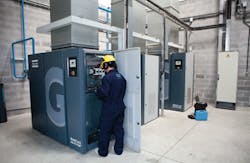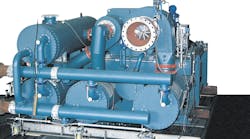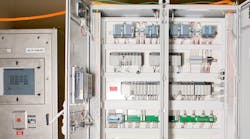When’s the last time you bought a new car? While shopping around, did you stop and consider the total costs involved? Over a car’s operating lifetime, thousands of dollars will be spent on fuel, new parts and repair & maintenance, above and beyond the vehicle’s initial purchase price.
The same is true of industrial equipment. Take a compressed-air system, a vital component in many processing facilities. The biggest single cost associated with producing compressed air is the energy required to power the compressor. It’s not rare at all for compressed air to account for up to 40% of the total energy a facility consumes on an annual basis.
That means maximizing compressed-air energy efficiency may be smartest thing a facility’s management can do to save money over the long term.
Moreover, the operational soundness of core compressed-air system components matters greatly when it comes to the lifetime optimization of an air-compressor system. On-going and proactive maintenance of the entire system, including compressed-air piping and filters, is vitally important for the compressed-air system’s health and the facility’s bottom line. Where piping leaks, there are pressure drops. They force the compressed-air system to work harder. Elimination of pressure drops throughout the compressed-air system has a domino effect that can result in significant and ongoing cost savings.
To start reducing compressed-air system pressure drops: 1) identify and fix leaks in the compressed-air piping, 2) prevent new leaks and 3) optimize the piping configuration.
Identify & fix
First step in reducing pressure drops is to identify leaks. Even the smallest compressed-air system leak can be a big drain on resources. For instance, a single quarter-inch air leak at 100 psi can cost as much as $8,000 a year in lost compressed air.
Compressed-air audits help facilities identify areas for improvement within the air system’s infrastructure. There are three types of audits: a basic audit, also referred to as "walking the line," data logging and full-system audit. Walking the line is the simplest procedures and comprises visual inspection of compressor system’s components, including but not limited to the compressor room, filters, piping and condensate drains. Larger leaks can often be found by walking the path of the air flow and listening for the leaks.
However, probably about 80 percent can’t be detected simply by putting the ear to the ground. For tiny leaks ultrasonic leak detection is used. In a typical facility, smaller leaks are primarily responsible for pressure drops and energy loss, so it is important to find and repair small leaks regularly.
An ultrasonic leak-detecting device delivers a great return on investment due to its ability to support the ongoing repair of small leaks.
Maintain or replace filters
Once leaks have been identified and fixed, it’s important to take steps to prevent new leaks from forming. Dust, corrosion-inducing moisture and the resulting pipe sludge leads to leaks that compromise efficiency and increase the risk of breakdown or end-product contamination.
Regular system maintenance not only prevents new leaks from forming, but also reduces risk. If compressed air is not filtered properly, or if the filter is clogged, pressure drops occur more frequently and product contamination risk increases. Changing filters systematically ensures compressed-air quality and prevents pressure drops.
However, it’s not enough to just inspect the compressed air filters. Maintaining air-line and point-of-use filters is just as important to compressed-air system optimization as maintenance of the air compressor and compressor room filters.
With the warm temperatures of the summer months and increased humidity, compressed air systems tend to experience additional water loading on the air-treatment equipment. Filters are affected by this additional moisture; increases in pressure drops in coalescing filters leads to higher compressor running costs. Therefore, replacing the filter element with a new one during the summer months decreases pressure drops and increases system efficiency.
Optimize piping configuration
Piping systems more than five years old have been shown to exhibit leaks of up to 25 percent, yet many facilities are slow to upgrade equipment. And even though there is a more efficient choice available, most facilities still use galvanized iron, or "black iron," for compressed air piping systems.
Black iron is very heavy, difficult to install and unfortunately, begins to rust as soon as it is installed, causing leaks in the system. Because couplings and elbows in a black-iron system must be threaded together, finding and fixing leaks involves taking large runs of piping apart. It’s a huge undertaking and leaks are often ignored for just this reason, even though remediation could save the largest facilities tens of thousands of dollars every year.
Aluminum piping virtually eliminates the corrosion seen in black iron or galvanized steel systems, making it a more efficient choice for piping material. A smooth inner bore allows air to pass through the pipe with less resistance, reducing pressure drops. Smooth air transfer makes aluminum piping more cost effective than black iron at the outset and the energy-saving benefits continue over the system’s lifetime. Plus, aluminum-piping installation takes about one-third of the time of a traditional system. And, due to the significantly lighter weight, it is easy to take apart and reconfigure, if a facility’s compressed air-system grows or changes over time.
Compressed air piping optimization goes beyond just piping system material. Undersized or oversized piping, poor configuration or clogged filters can create significant artificial demand. Thus, it is important to resist the urge to turn up pressure to compensate for this demand. Rather, checking the system pressure and identifying and addressing maintenance issues is the smarter, more efficient way to operate.
While maintenance best practices can have a profound impact on compressed-air system efficiency, upgrading to new technology can also save and position facilities to meet future efficiency requirements. Some new compressors are quieter than ever before and can be installed closer to the point of use. The closer the compressor to point of use, the less piping needed. Less piping means reduced pressure drops occurring over lengthy piping runs and reduced opportunities for air system leaks. Combined with maintenance best practices, consistent air pressure levels, more efficient compressed air system and energy savings can be achieved.
David Ritchie is AIRnet Marketing Supervisor, Atlas Copco Compressors LLC.
In 2013, Atlas Copco celebrated its 140th birthday. From its beginnings as a maker of railroad rolling stock it has grown to a global provider of compressors, construction mining equipment, power tools and assembly systems, with 111 locations and more than 4,500 employees in the United States.


